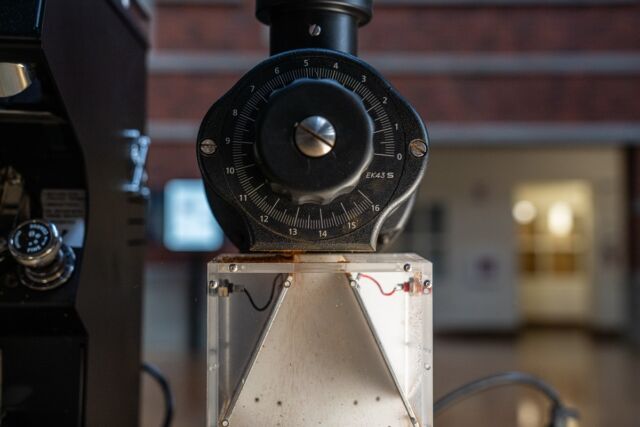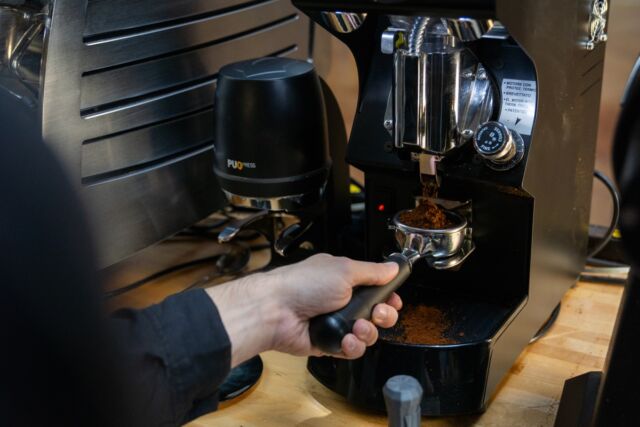Scientific inspiration can strike at any time. For Christopher Hendon, a computational materials chemist at the University of Oregon, inspiration struck at a local coffee bar where his lab holds regular coffee hours for the Eugene campus community—a fitting venue since Hendon's research specialties include investigating the scientific principles behind really good coffee. The regulars included two volcanologists, Josef Dufek and Joshua Méndez Harper, who noted striking similarities between the science of coffee and plumes of volcanic ash, magma, and water. Thus, an unusual collaboration was born.
“It’s sort of like the start of a joke—a volcanologist and a coffee expert walk into a bar and then come out with a paper,” said Méndez Harper, a volcanologist at Portland State University. “But I think there are a lot more opportunities for this sort of collaboration, and there’s a lot more to know about how coffee breaks, how it flows as particles, and how it interacts with water. These investigations may help resolve parallel issues in geophysics—whether it’s landslides, volcanic eruptions, or how water percolates through soil.”
The result is a new paper published in the journal Matter demonstrating how adding a single squirt of water to coffee beans before grinding can significantly reduce the static electric charge on the resulting grounds. This, in turn, reduces clumping during brewing, yielding less waste and the strong, consistent flow needed to produce a tasty cup of espresso. Good baristas already employ the water trick; it's known as the Ross droplet technique, per Hendon. But this is the first time scientists have rigorously tested that well-known hack and measured the actual charge on different types of coffee.
As previously reported, there's actually an official industry standard for brewing espresso, courtesy of the Specialty Coffee Association, which sets out strict guidelines for its final volume (25-35 mL, or roughly one ounce) and preparation. The water must be heated to 92° to 95°C (197° to 203°F) and forced (at a specific pressure) through a bed of 7 to 9 grams (about a quarter of an ounce) of finely ground coffee for 20 to 30 seconds. But most coffee shops don't follow this closely, typically using more coffee, while the brewing machines allow baristas to configure water pressure, temperature, and other key variables to their liking. The result of all those variations in technique is a great deal of variability in quality and taste.
In 2020, Hendon's lab helped devise a mathematical model for brewing the perfect cup of espresso, over and over, while minimizing waste. The flavors in espresso derive from roughly 2,000 different compounds that are extracted from the coffee grounds during brewing.
So Hendon and his colleagues focused on building a mathematical model for a more easily measurable property known as the extraction yield (EY): the fraction of coffee that dissolves into the final beverage. That, in turn, depends on controlling water flow and pressure as the liquid percolates through the coffee grounds. Hendon et al. based their model on how lithium ions propagate through a battery's electrodes, which they liken to how caffeine molecules dissolve from coffee grounds.

Josef Dufek and Christopher Hendon prepare filter coffee in the Oregon Coffee Laboratory. (credit: University of Oregon)
A bunch of simulations and several thousand experimental shots of espresso later, the authors concluded that the most reproducible thing you can do is use fewer coffee beans and opt for a coarser grind with a bit less water; brew time was largely irrelevant. Conventional wisdom holds that a fine grind is best since more surface area of the resulting tamped-down coffee bed is exposed to the hot water, thus boosting the extraction yield. But the group's experiments revealed that if coffee is ground too finely, it can clog the coffee bed, thereby reducing extraction yield. It's also a big factor in the variability in taste.
This latest research focused on why the microscopic clumps form in the first place, particularly at very fine grind levels. The culprit is static electricity arising from the fracturing and friction between the beans during grinding. Hendon thought reducing that static would be a good way to eliminate those clumps. The technical term is triboelectricity, which arises from the accumulation of opposite electric charges on the surfaces of two different materials due to contact with each other. (It should not be confused with triboluminescence, the emission of cold light when a material is subjected to physical deformation—the reason Wint-O-Green Life Savers emit blue sparks when crushed, visible in the dark.)
A similar charge build-up also occurs during volcanic eruptions. “During eruption, magma breaks up into lots of little particles that then come out of the volcano in this big plume, and during that whole process, those particles are rubbing against each other and charging up to the point of producing lightning,” said Méndez Harper. “In a simplistic way, it’s similar to grinding coffee, where you’re taking these beans and reducing them to fine powder.” Since the particle-scale physics that occurs in volcanic plumes is quite difficult to study in nature, collaborating with Hendon to study triboelectric effects in coffee provided a useful smaller-scale platform.

A coffee grinder and electrostatic separator. (credit: University of Oregon)
For its experiments, the team first acquired various kinds of commercially roasted coffees, covering a broad range of colors from light to dark roasts, and lumped them into three categories: natural, washed, and decaffeinated. They used a dark roast (Starbucks Blonde Espresso Roast) with a water content of 1.3 percent to assess the surface charging of whole beans—achieved by rolling the beans down a vibrating ramp coated in various materials likely to be found in a coffeehouse environment. The beans ended up in a Faraday cup at the bottom of the ramp, where their electrical charge was calculated. The results: the beans weakly charged when rolled down steel, took on a positive charge against glass and nylon, and a negative charge against plastics like PVC and Mylar.
Next, the researchers tested the grinding process, placing a Faraday cup under the grinder chute to measure how much electrical static accumulated on the ground beans, varying coffee varieties, roasting levels, and grind settings. They determined that several different factors played a role in how much triboelectrification occurred during grinding.
For instance, lighter roasts have more internal moisture than darker roasts, and the latter is more prone to clumping. Spritzing water on the beans before grinding reduced the static electricity. “Moisture, whether it’s residual moisture inside the roasted coffee or external moisture added during grinding, is what dictates the amount of charge that is formed during grinding,” said Hendon. “Water not only reduces static electricity and therefore reduces mess as you’re grinding, but it can also make a major impact on the intensity of the beverage and, potentially, the ability to access higher concentrations of favorable flavors."

Grinding dry coffee into an espresso portafilter. (credit: University of Oregon)
In other words, the baristas were right all along. “Some baristas may have already anecdotally arrived at our conclusions; it's validating some industry know-how,” Hendon said. “We are advocating for yet another step in producing excellent quality coffee, but it turns out you can’t cut corners if you want to achieve excellence.”
Water content also plays a role in explosive volcanic eruptions, per Dufek, charging ash particles that can lead to lightning storms as well as determining how long that ash remains airborne and how far it travels after an eruption. Among other findings: dark roasts tended to develop a negative charge, while lighter roasts took on a positive charge. Coarser grinds also resulted in less charge accumulation. Coffee bean origin or processing method did not have any impact on charging. So Hendon et al. concluded that it is the interplay between bean color and moisture content that are the primary factors at play in the phenomenon.
Matter, 2023. DOI: 10.1016/j.matt.2023.11.005 (About DOIs).


 Don’t like seeing Global Shared Stories or the River of News on the Dashboard? You can hide them with this little bit of CSS:
Don’t like seeing Global Shared Stories or the River of News on the Dashboard? You can hide them with this little bit of CSS: